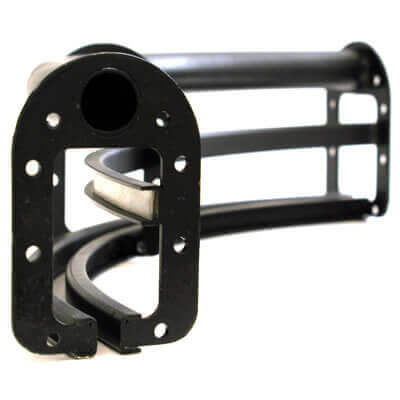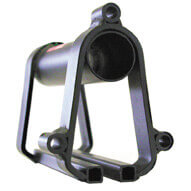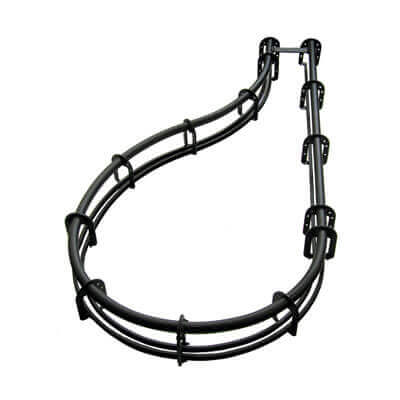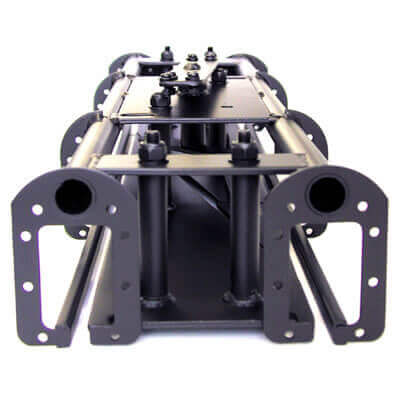Curtains and tracks - types and applications
As well as being a necessity for the stage, curtains can also be a flexible and cost-effective way to divide a room for dual or multiple use, or to control acoustics. Clever use of the right type of curtain, with the appropriate mechanisms and tracks, can transform a room without the need for expensive and disruptive building work.
Let’s use a school hall as an example, and let’s suppose it’s going to be used for lessons as well as a drama studio and theatre.
For drama, it will need a curtain all around the room. The curtain could in a number of pieces to give flexibility to the types of production that can be performed. It will also help to stop sound travelling into other classrooms and vice versa.
The curtain will need to be easily moved and compactly stored to convert the studio or theatre back for normal use.
The weight of curtain will be dictated by three main factors: use, where they will hang, and who will operate them. For example, they can’t be too heavy if they are to be operated by children.
Tracks
The choice of track depends first of all on the weight of the curtains you intend to hang from it. There are other factors too such as the type of mechanism you’ll be using to operate the curtains, the application, and of course, the size and shape of the space. Here are the main types of track we recommend when converting a hall for dual purpose:
Lightweight

This type of track is usually aluminium and can be used on small stages, and in venues such as community or civic halls, churches and crematoriums. It’s not intended for use on a professional stage.
It has a good range of uses for example with window curtains, or blackout curtains in schools and colleges.
Medium/heavy duty tracks
 These are used in professional theatres. A steel cable inside the track winds onto a winch, which is operated by hand or is electrically driven via an exterior motor. It can also be a cord or walk a along operation. Some applications will use an electrically driven chain or belt.
These are used in professional theatres. A steel cable inside the track winds onto a winch, which is operated by hand or is electrically driven via an exterior motor. It can also be a cord or walk a along operation. Some applications will use an electrically driven chain or belt.
Heavy duty tracks
 The mechanism is the same as above and they are used in large theatres, TV and film studios.
The mechanism is the same as above and they are used in large theatres, TV and film studios.
Banjo track
 You can’t change the colour of a black backdrop curtain at the rear of stage using lights, so you use a banjo track. It spins the black backdrop around so that a coloured curtain, or it could be a cyclorama cloth, on the other side comes to the front.
You can’t change the colour of a black backdrop curtain at the rear of stage using lights, so you use a banjo track. It spins the black backdrop around so that a coloured curtain, or it could be a cyclorama cloth, on the other side comes to the front.
You can change every curtain on the stage, or in the wings, using this type of track.
The track is on a raise or lower system to make it easier to changing scenery or curtains.
Switch point track
 This track has a point system – rather like a railway track – which allows you to alter the direction of the curtains or to stack them.
This track has a point system – rather like a railway track – which allows you to alter the direction of the curtains or to stack them.
The point system allows you to move the curtain onto another track. The system is used on a professional stage when the curtain needs to be stacked off stage in one of the wings.
The track comes in all shapes and sizes, and the points are changed with a pull lever.
Curtain track mechanisms
The choice of mechanism depends on the type of curtain and track, what the curtains will be used for, and importantly, who will be operating them.
Storage is another consideration as some of the mechanisms are bulky and take up quite a bit of space.
There are six different types used in theatre:
 Electric – this makes heavy-duty curtains much easier to operate. It makes it easier and faster to move curtains and is preferred by professional theatres, that will have a lot of scene changes, for use with front of house curtains.
Electric – this makes heavy-duty curtains much easier to operate. It makes it easier and faster to move curtains and is preferred by professional theatres, that will have a lot of scene changes, for use with front of house curtains.
 Hand winch with steel cable (wall or floor mounted) – this is used only with the front of house curtains and usually in smaller to medium size venues such as school and community halls.
Hand winch with steel cable (wall or floor mounted) – this is used only with the front of house curtains and usually in smaller to medium size venues such as school and community halls.
 Cord operated with a weighted or floor tension pulley. The cord is pulled by hand and can be used with most tracks .It can be used for backdrops, intermediate (centre stage curtains) and front of house curtains in smaller venues.
Cord operated with a weighted or floor tension pulley. The cord is pulled by hand and can be used with most tracks .It can be used for backdrops, intermediate (centre stage curtains) and front of house curtains in smaller venues.
 Walkalong – a good option for a school or community hall. It can be used with a perimeter track or to divide a room for example.
Walkalong – a good option for a school or community hall. It can be used with a perimeter track or to divide a room for example.
 Chain drive - electrically driven and will drive any of the medium to heavyweight tracks. A chain track with master carrier is highly versatile and competitively priced. The low noise motors are variable speed with optional encoders for positional control and they can run through 90°, 250mm radius curves. These features make them ideal for crematoriums. They are also suited to theatres with a raise and lower bar system. The motor is attached to the track so you don’t have to worry about the cables coming off the drum when you lower the bar to change the curtain.
Chain drive - electrically driven and will drive any of the medium to heavyweight tracks. A chain track with master carrier is highly versatile and competitively priced. The low noise motors are variable speed with optional encoders for positional control and they can run through 90°, 250mm radius curves. These features make them ideal for crematoriums. They are also suited to theatres with a raise and lower bar system. The motor is attached to the track so you don’t have to worry about the cables coming off the drum when you lower the bar to change the curtain.
 Belt driven system - suitable for medium weight applications up to 10m long. Excellent where there isn’t enough room to mount a conventional curtain controller. It’s ideal for schools and multi-purpose venues. As with the chain driven system, it’s suited to theatres with a raise and lower bar system but because of its limitations, it’s more often used in medium sized venues.
Belt driven system - suitable for medium weight applications up to 10m long. Excellent where there isn’t enough room to mount a conventional curtain controller. It’s ideal for schools and multi-purpose venues. As with the chain driven system, it’s suited to theatres with a raise and lower bar system but because of its limitations, it’s more often used in medium sized venues.



